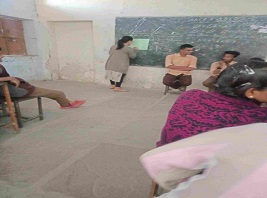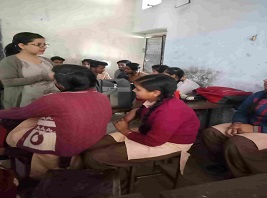Session on Violence with children at Saheed Major Digvijay Singh Sumal Govt. Sr. Sec. School in Khatipura, Parivahan Nagar, Jaipur, Rajasthan (January, 2020)
Violence with children and its impacts
Summary of violence with children
The definition of violence- The UNCRC considers violence to happen when someone's mind is hurt as well as their body.
Forms of violence by UNCRC: Mental violence, Physical violence, Sexual violence, Violence through information and communication technologies, Violence in mass media, Self-harm, torture or inhuman and degrading treatment or punishment.
ARTICLES :
Article 24 - Children and young people should be protected from the traditional practices that are violent against them. Article 25 - If a child or a young person is living away from home, they should be regularly checked upon, in case, they are not safe. Article 28- No one should be violent against children or young people at school. Article 34 - Children and young people shouldn't be exploited sexually. Article 37 - Children and young people shouldn't be punished in a cruel or degrading way. Article 38- There are rules relating to the involvement of children and young people along with the armed forces. Article 39 - Children and young people should be helped to recover, if they are survivors of violence.
Socially accepted forms of violence, such as shouting at children and corporal punishment, are often not perceived as violent behavior. However, studies indicate that the majority of child abuse occurs at the hands of people known to the child, rather than by strangers. The effects of violence on children can vary based on their age and developmental stage. Exploitation, violence, abuse, and neglect can harm children emotionally, socially, and within their family relationships, and can lead to loss of self-respect, trust, self-esteem, and the joy of childhood. It corrupts, kills, and destroys children, and debases our societies. As parents, it is our primary responsibility to protect our children from violence. Violence against children is unacceptable in all settings, including the home, schools, care or justice institutions, and the community. Parents who resort to violence in their upbringing will not learn alternative methods of educating and dealing with their children.
Activity conducted during the session
Pre-session assessment
Which children are safe? Some students responded that children who are well-behaved, educated, from affluent families, without bad habits, and with good family support are safe. One student said that no children are entirely safe. One boy replied that physically and mentally fit children are safe. Which children are not safe? Some students responded that uneducated children, those with bad habits, orphaned children, those who lack knowledge about society, children from low-income families, and those whose parents are not good are unsafe in society. One student mentioned that disabled children are also at risk. What factors make a child safe or unsafe? Most of the students mentioned that family, education, knowledge, and good behavior make a child safe. Some students mentioned that having good friends, healthy food, a good environment, good teachers, decent people in society, and good parenting also make a child safe. Most of the students mentioned that bad habits, a destructive society, and misuse of social media make a child unsafe.
Story Writing
We Formed 4 groups and each group had to write one imaginary story of each of the following types of violence: Physical, emotional violence, sexual violence, exploitation, and negligence. Students wrote the following stories:
Story on Physical violence: Once there was a girl who was 14 years old and she had been harassed for 4 years. In her village, one lady forced her to come to the prostitution business and sold her. When she rejected to do this she was tortured by those people. They didn’t leave that any mercy to her. Then she ran from that place and went to the police station at the railway station and told her whole story to them then the police bring caught them and she got her justice. Story on emotional violence: A child is violated emotionally when he doesn’t fulfill their family expectation so the family scolded them. Forced him to study, insult him in front of their relatives, discriminate between the children, practice untouchability and child marriage all these factors impact the mental and emotional health of a child. Students also wrote that if parents extremely force their child for studies which can make a child emotionally weak that’s why we should talk nicely with children and show them the right direction. Story on sexual violence: These days the cases of rape and sexual harassment are increasing which is the reason for insecurity among girls. For E.g. the horrifying case of “Dr. Priyanka Reddy” of Hyderabad. Every time a girl/woman is harassed by a boy irrespective of age, everyone feels unsafe. Girls are not even safe in with relatives. they cannot play freely and cannot hang out in parks because of such incidents. Parents also feel that their girl child is a burden for them. We should make a safe society for everyone. Story on neglecting: In society, families don’t fulfill their child's requirements because of the poor financial conditions of their family. They exploit them and even children have no right to speak. Sometimes family ignore their children. Family unheard their children and their problems increase because they don’t understand the safety of their child and don’t give so much importance to their things. Just as, One girl told her mother that one boy harassed her by the road and her parents ignored her problem and told her to change her way of coming home. That boy continued to harass that girl and because of that girl’s life went in the wrong direction. Her family always ignored her problems because the boy was her cousin and in end her parents regretted by their actions because the boy sexually harassed that girl.
Movie screening
The Rose: This short film is based on Child Rights (Corporal Punishment).The most useful information on Child Abuse. Call on 1098 to report about it. All your information is safe with ChildLine India.(Video Link: https://youtu.be/bqyb4PoLDKc ) KOMAL A film on Child Sexual Abuse (CSA): Komal is like any other bright, sensitive, and happy 7-year-old girl. Her new neighbor Mr. Bakshi, who moved in with his wife, is her father's old friend. Komal bonds with the affable Mr. Bakshi with whom she has a whale of a time. Until Komal discovers Mr.Bakshi's bitter reality. (Video Link: https://youtu.be/CwzoUnj0Cxc )
UNICEF: Stop Child Abuse Now !: Are there 100,000 people who care enough to protect our children from abuse? Let us show abusers in our society we will not tolerate them hurting our children anymore. (Video Link: https://youtu.be/CJzbDn58eTA)
Post session assessment
Which forms do you think are the most common and which type of children are most at risk of the different types of violence? Students answered that girls more have to face sexual abuse and boys have to face more physical abuse. Some students answered that boys and girls have both face neglect violence from their parents. Most of the students replied that children face physical violence compare to other types of violence. What is the impact of the different forms of violence on children? Some students responded that a child can commit suicide, become depressive and sad, stressful, aggressive, leave home and studies, irritated, lonely, will not share anything with anyone, and have low self-confidence.






